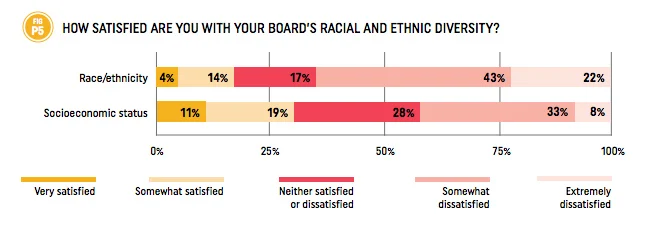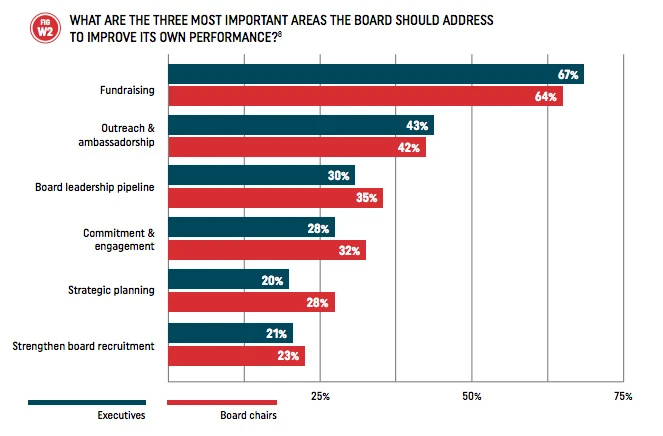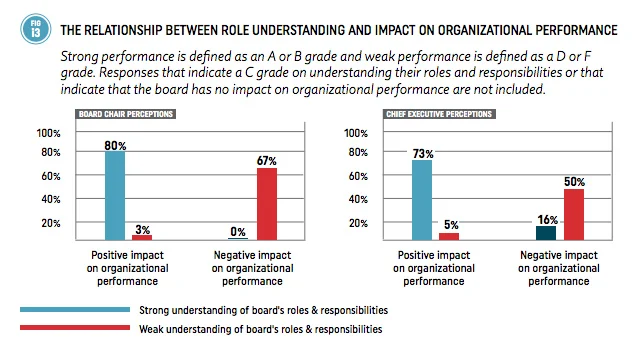Nonprofit boards seem to be more eager than in years past to advocate on behalf of the organizations they represent. But who exactly is doing that lobbying, which can set standards for how social missions are structured and who in the community becomes involved, is still troubling–as in, everyone is white.
That’s two of the key findings in Leading with Intent, a new report about board composition, practices, and performance and culture by BoardSource, a nonprofit working to improve governance within the sector.
When BoardSource surveyed over 1,750 executives within the industry, it found that 90% all nonprofit CEOs are white, as are 84% of board members. That’s up from its 2015 findings, which were 89% and 80% respectively. Overall, within that time frame the total number of all-white boards rose too, from 25% to 27%, despite the fact that many leaders are clearly dissatisfied with the imbalance.
On top of that, many boards aren’t involved enough, leaving them ignorant of the ways a group may be trying to improve its effectiveness or what they can do to help. That ignorance can be compounded if everyone already shares the same perspective, something the industry has taken to calling its “privilege problem.”
“It’s just really, really clear that, when it comes to more diversity, we’re stuck,” says BoardSource CEO Anne Wallestad. “The issue here is that despite what boards and executives are saying about the importance of diversity for their organizations mission and work, they are not prioritizing diversity in their board recruitment practices. And so there’s a real dissonance there between values and words, and actions and tangible work.”
As Fast Company has reported, many organizations are upset about the lack diversity throughout all levels of this sector, along with the continued hiring practices that obviously perpetuate it. In fact, a recent employment study shows that may be part of the reason that social enterprises are sucking up an increasing amount of nonprofit talent. People don’t want to work where they don’t feel welcome.
To that end, at 65% of CEOs and 41% of board members reported being somewhat or extremely dissatisfied with their board’s racial and ethnic diversity but only 20% considered it a top priority to actually fix it. “If you have a board that is homogeneous, that is kind of universally privileged, that has limited exposure or understanding of the communities that you’re serving, that’s a real problem,” says Wallestad.

At the same time, all leaders ranked fund-raising, outreach, and ambassadorship, and building a pipeline for future leaders on the board as the places where they could most improve.

One of the most interesting findings, Wallestad notes, is that board members who take time to socialize at meetings or during an annual retreat report feeling more like a collaborative team with a shared goal. Conversely, three times as many board members who didn’t structure in time to connect with their fellow board members felt an obvious lack of collaboration.

“That might sound silly to some, but the importance that the board actually having time to get to know each other and to build that ability to work well as a team . . . it really mattered,” Wallestad says.
The group’s true goal in commissioning the study was not just to point out what’s wrong, but to set groups on a path to fix it. So the report concluded with a series of questions for leaders to gauge whether they have the right understanding of their own group mission and all of the potential ways they might boost or hinder diversity, inclusion, a strong work culture, and, ultimately, more societal success.
“Of the board chairs who said that their board had a negative impact on organizational performance, 67% of them said that the board also had a weak understanding of the board’s roles and responsibility,” she says. Most who claimed to really understand the job felt like they were able to make a positive impact.
Recognize your brand’s excellence by applying to this year’s Brands That Matter Awards before the early-rate deadline, May 3.
